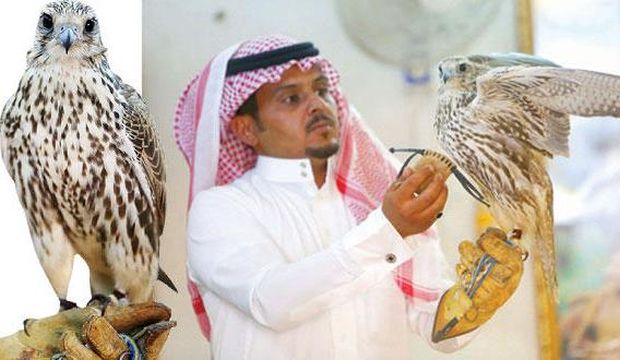Riyadh, Asharq Al-Awsat—”Every year in mid-October, my friends and I pack up a car to travel to the northern and western part of the Saudi Arabian desert. We earn hundreds of thousands of riyals from this month-long business venture,” says Ra’ad Al-Mizani, who joined the falconry profession 10 years ago.
Mizani travels hundreds of kilometers during his annual trip—starting in the Al-Qassim district and moving to the furthest ends of the Kingdom—in search of migratory falcons, which he describes as “jewels with wings.”
The trip is both exhausting and risky for those embarking on it, and requires one to live a temporarily primitive existence—which is evident in those who return: their skin is darker, their faces are skinnier, and their hair much longer. Yet, the lucrative earnings that stand to be gained in this profession mean any discomfort experienced on the trip is often forgotten, Mizani says.
After returning from the hunt, falconers flock to houses of their wealthy Gulf Arab buyers to present their potential sales. After everyone has agreed upon a price and the birds are sold, the falconers divide the money equally between themselves. Mizani says the most expensive bird he has yet sold was a Lanner falcon for 280,000 Saudi riyals (70,000 US dollars) nearly three years ago.
The falcon hunting season begins on October 10 and ends at the end of the new calendar year. During this period, the birds migrate from their home country, crossing the northern Al-Hamad Desert and then flying along the western coast. Prices range range widely, with the lucky hunter catching the more expensive kind. Some famous hunters who deal with prominent merchants can earn up to thousands of riyals each season, Manis says.
One particularly popular hunting method involves setting up traps containing quails or doves, so the falcon is captured after it swoops down for its prey. Another method involves sending other birds into the air to lure the falcon down. However, this relies on the falconer’s proficiency and the quality of the bird used as prey. Above all, Manis says, the most important skill in falcon hunting is selecting the proper spot for the trap—and then to wait patiently.
Jamal Bin Labdah, a renowned falconer in Saudi Arabia, says the falcon market is somewhat complex and requires the falconer to have a vast knowledge of the different kinds of the birds, their prices, and their migration patterns. The most expensive kind, the Lanner Falcon, can reach anywhere up to 220,000–400,000 riyals (59,000–107,000 dollars).
A falcon’s price depends on its beauty and color. A white falcon with bluish–black eyes is the most in demand, especially if it also has a white head, Labdah says. The Peregrine falcon is the next most-valuable, ranging from 70,000–250,000 riyals (19,000–67,000 dollars). The cheapest, a smaller type of the Lanner Falcon (known as the “Wakari” in Arabic), never fetches anything more than 5,000 riyals (1,300 dollars). The Lanner and Peregrine falcons migrate yearly from Russia and Mongolia, which have the best types of falcons in the world, Labdah maintains.
Falcons usually live for around 20 years. A younger falcon is more valuable until reaching the age of four, at which point the price decreases, with a more dramatic decrease from the age of 15. Whether the bird is male or female has no effect on the price.
Not all falconers in the Kingdom are Saudis. Some travel thousands of miles from across the Gulf region to indulge their hobby—or, perhaps, in this case, their obsession. Maeed Al-Amri, a falconer from the UAE who travels over 1,000 miles from Abu Dhabi toward the Al-Hamad Desert in the Kingdom, says he and his friends come all the way to Saudi Arabia to hunt falcons out of their love for the sport, and not out of any desire for financial gain. He and his fellow falconers eagerly anticipate this season every year, and the competition is usually quite fierce, he says.
Amri prefers hunting for falcons in Saudi Arabia due to its having such a large population of the birds. He also cites security in the country, and says he has never been harassed by local Saudi falconers, whom he now considers colleagues and friends after established close relationships with them.
The falconry market in Saudi Arabia teems with enthusiasts from other Gulf countries, particularly as, unlike some of these countries, the practice is legal in the Kingdom, something which encourages Amri and other falconers from the Gulf to head to there during the hunting season.


Trackbacks/Pingbacks